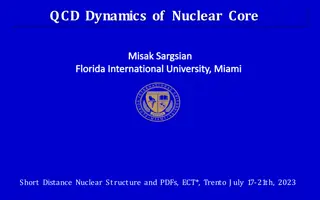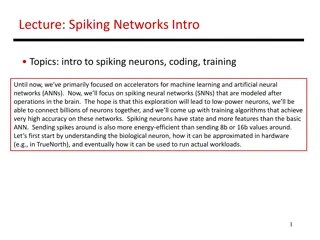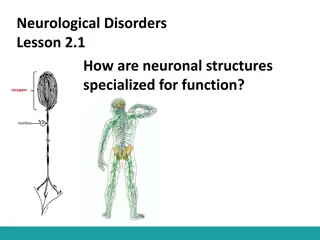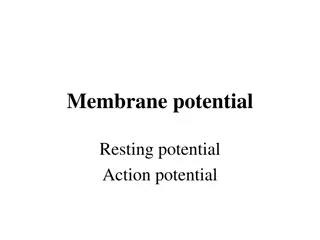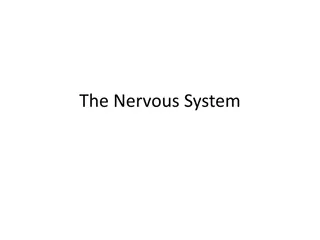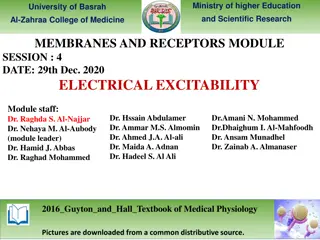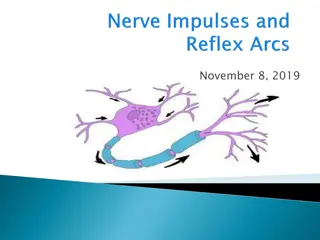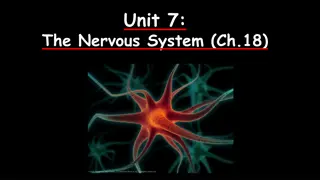Action Potentials in Neurons
Action potentials are rapid changes in voltage across cell membranes, crucial for signaling in neurons and muscle cells. Stimuli trigger depolarization by opening sodium channels, followed by repolarization and hyperpolarization. Resting membrane potentials and ion gradients play key roles in establishing the cellular voltage dynamics.
Uploaded on Feb 17, 2025 | 2 Views
Download Presentation

Please find below an Image/Link to download the presentation.
The content on the website is provided AS IS for your information and personal use only. It may not be sold, licensed, or shared on other websites without obtaining consent from the author.If you encounter any issues during the download, it is possible that the publisher has removed the file from their server.
You are allowed to download the files provided on this website for personal or commercial use, subject to the condition that they are used lawfully. All files are the property of their respective owners.
The content on the website is provided AS IS for your information and personal use only. It may not be sold, licensed, or shared on other websites without obtaining consent from the author.
E N D
Presentation Transcript
Dr Kapil Garg Dept. Of Musculoskeletal Physiotherapy MGM Institute Of Physiotherapy Chh. Sambhajinagar
Action potential An action potential is a rapid rise and subsequent fall in voltage or membrane potential across a cellular membrane with a characteristic pattern. ... Examples of cells that signal via action potentials are neurons and muscle cells. Stimulus starts the rapid change in voltage or action potential
Stimulus starts the rapid change in voltage or action potential. In patch-clamp mode, sufficient current must be administered to the cell in order to raise the voltage above the threshold voltage to start membrane depolarization. Depolarization is caused by a rapid rise in membrane potential opening of sodium channels in the cellular membrane, resulting in a large influx of sodium ions.
Membrane Repolarisation results from rapid sodium channel inactivation as well as a large efflux of potassium ions resulting from activated potassium channels. Hyperpolarisation is a lowered membrane potential caused by the efflux of potassium ions and closing of the potassiumchannels. Resting state is when membrane potential returns to the resting voltage that occurred before the stimulus occurred.
Membrane Potential Imagine taking two electrodes and placing one on the outside and the other on the inside of the plasma membrane of a living cell. If you did this, you would measure an electrical potential difference, or voltage, between the electrodes. This electrical potential difference is called the membranepotential.
Resting membrane potential A resting (non-signaling) neuron has a voltage across its membrane called potential, orsimply the resting potential. the resting membrane The resting potential is determined by concentration gradients of ions across the membrane and by membrane permeability toeach typeof ion.
In a resting neuron, there are concentration gradients across the membrane for Na+ and K+. Ions move down their gradients via channels, leading to a separation of charge thatcreates the resting potential. The membrane is much more permeable to K+ than Na+, so the resting the equilibrium potential of K+ (the potential that would be generated by K+ if it were the only ion in the system). potential is close to
For a cells membrane potential, the reference point is the outside of the cell. In most resting neurons, the potential difference across about 30 to 90 V, with the inside of the cell more negative than the outside. That is, neurons have a resting membrane potential (or simply, resting potential) of about -30 MV, to - 90 MV. the membrane is
Because there is a potential difference across the cell membrane, the membrane is said to be polarized. If the membrane potential becomes more positive than it is at the resting potential, the membrane is said to be depolarized. If the membrane potential becomes more negative than it is at the resting potential, the membrane is said to be hyperpolarized.
Saltatory conduction Saltatory conduction is the propagation of action potentials along myelinated axons from one node of Ranvier to the next node, increasing the conductionvelocityof action potentials.


